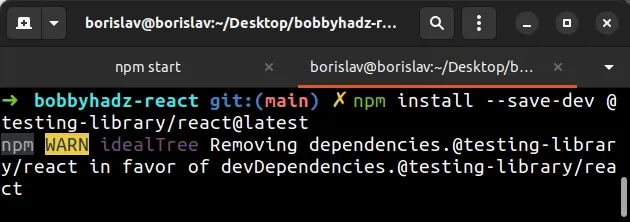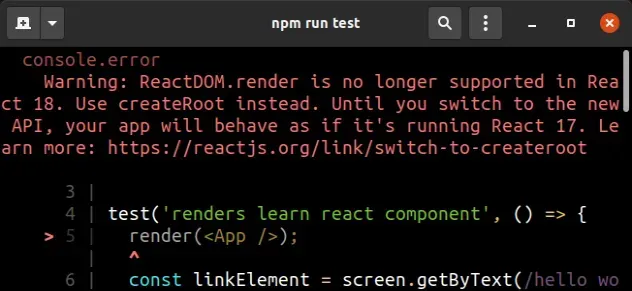ReactDOM.render is no longer supported in React 18
Last updated: Apr 7, 2024
Reading time·5 min

# Table of Contents
- ReactDOM.render is no longer supported in React 18
- React Testing library - ReactDOM.render no longer supported in React 18
React testing library, click on the second subheading.# ReactDOM.render is no longer supported in React 18
The error "ReactDOM.render is no longer supported in React 18. Use createRoot
instead" occurs because the ReactDOM.render method has been deprecated.
To solve the error, create a root element and use the ReactDOMClient.render
method instead.

Here is an example of how the error occurs in the index.js file of a React v18
app.
import {StrictMode} from 'react'; import ReactDOM from 'react-dom'; import App from './App'; // ⛔️ ReactDOM.render is no longer supported in React 18. // Use createRoot instead. Until you switch to the new API, // Your app will behave as if it's running React 17. ReactDOM.render( // 👈️ deprecated starting React 18 <StrictMode> <App /> </StrictMode>, document.getElementById('root'), );
To solve the error, create a root element and use the ReactDOMClient.render
method instead.
import {StrictMode} from 'react'; import {createRoot} from 'react-dom/client'; import App from './App'; // 👇️ IMPORTANT: use the correct ID of your root element // This is the ID of the div in your index.html file const rootElement = document.getElementById('root'); const root = createRoot(rootElement); // 👇️ if you use TypeScript, add non-null (!) assertion operator // const root = createRoot(rootElement!); root.render( <StrictMode> <App /> </StrictMode>, );
The render() method of the
react-dom package is considered legacy starting react-dom version 18.
The method is replaced with the
createRoot() method
that is exported from react-dom/client.
createRoot() method takes the root element as a parameter and creates a React root.The root has a render() method that can be used to render a React element into
the DOM. The root in React is a pointer to the top-level data structure that
React uses to track a tree to render.
In the new API, we create a root and then call the render() method on it.
# Remove the strict mode wrapper
If your app doesn't work after updating to React 18, check whether it's wrapped
in <StrictMode>.
Strict mode was changed
in React 18 and has more checks than it did in previous versions.
If the warning is still shown after making the changes, make sure to update your
@testing-library/* versions as well.
npm install --save-dev @testing-library/react@latest npm install --save-dev @testing-library/jest-dom@latest npm install --save-dev @testing-library/user-event@latest

Now you should be able to start your tests without getting the error.
import {render, screen} from '@testing-library/react'; import App from './App'; test('renders react component', () => { render(<App />); const divElement = screen.getByText(/hello world/i); expect(divElement).toBeInTheDocument(); });
We had to update the version of the @testing-library/react package because
version 13 adds support for React 18.
In version 13, React testing library drops support for React 17 and earlier and uses the new createRoot API by default.
An alternative solution to get rid of the warning is to revert your versions of
the react and react-dom packages to an older version, e.g. 17.0.2 by
running npm install react@17.0.2 react-dom@17.0.2, but this is not
recommended.
You can read more about the breaking changes in React 18 in their Github release page, but chances are you won't be affected by the breaking changes and you'll take advantage of better performance by updating to React 18.
The ReactDOM.hydrate() method has also been deprecated in React.js 18 and has been replaced with hydrateRoot.
import {hydrateRoot} from 'react-dom/client'; import App from './App'; const rootElement = document.getElementById('root'); // Create *and* render a root with hydration. const root = hydrateRoot(rootElement, <App />); // Unlike with createRoot, you don't need a separate root.render() call here
The
unmountComponentAtNode()
method has been replaced with root.unmount() in React 18.
// Before unmountComponentAtNode(container); // After root.unmount();
When the unmount() method is called on the root element, it is removed from
the DOM.
The findDOMNode() method
has also been deprecated in StrictMode starting React v 18.0.0.
You can read more about the changes in React 18.0 in this GitHub release page.
You can also check out the official How to Upgrade to React 18 Guide.
Note that there are some surprises around using strict mode. For example, you might notice that console.log() gets printed twice.
# React Testing library - ReactDOM.render no longer supported in React 18
To solve the react testing library error "ReactDOM.render is no longer
supported in React 18", update the version of the react testing library by
running npm i -D @testing-library/react@latest.
Version 13.0.0 of the package adds support for the new createRoot API.

Open your terminal in the root directory of your project and run the following commands:
npm install --save-dev @testing-library/react@latest npm install --save-dev @testing-library/jest-dom@latest npm install --save-dev @testing-library/user-event@latest
Make sure to update the versions of all react testing library packages you are using.
Your index.js file should use the new createRoot API to render your
application.
import {StrictMode} from 'react'; import {createRoot} from 'react-dom/client'; import App from './App'; // 👇️ IMPORTANT: div ID has to match with index.html const rootElement = document.getElementById('root'); const root = createRoot(rootElement); // 👇️ If you use TypeScript, add non-null (!) assertion operator // const root = createRoot(rootElement!); root.render( <StrictMode> <App /> </StrictMode>, );
Now you should be able to start your tests without getting the error.
import {render, screen} from '@testing-library/react'; import App from './App'; test('renders react component', () => { render(<App />); const divElement = screen.getByText(/hello world/i); expect(divElement).toBeInTheDocument(); });
We had to update the version of the @testing-library/react package because
version 13 adds support for React 18.
In version 13, React testing library drops support for React 17 and earlier and uses the new createRoot API by default.
If you want to opt out of the change, you can set the legacyRoot property to
true when rending, e.g. render(ui, {legacyRoot: true}). However, this is not
recommended because the ReactDOM.render() method is deprecated starting React
18 and its usage triggers warnings in the console.
The render() method of the
react-dom package is considered legacy starting react-dom version 18.
The method is replaced with the
createRoot() method
that is exported from react-dom/client.
createRoot() method takes the root element as a parameter and creates a React root.The root has a render() method that can be used to render a React element into
the DOM. The root in React is a pointer to the top-level data structure that
React uses to track a tree to render.
In the new API, we create a root and then call the render() method on it.
If your app doesn't work after updating to React 18, check whether it's wrapped
in <StrictMode>.
Strict mode was changed
in React 18 and has more checks than it did in previous versions.
An alternative solution to get rid of the warning is to revert your versions of
the react and react-dom packages to an older version, e.g. 17.0.2 by
running npm install react@17.0.2 react-dom@17.0.2, but this is not
recommended.
You can read more about the breaking changes in React 18 in their Github release page, but chances are you won't be affected by the breaking changes and you'll take advantage of better performance by updating to React 18.
You can also check out the official How to Upgrade to React 18 Guide.

